Sergio Arnaldo
VoloGAN: Adversarial Domain Adaptation for Synthetic Depth Data
Jul 19, 2022



Abstract:We present VoloGAN, an adversarial domain adaptation network that translates synthetic RGB-D images of a high-quality 3D model of a person, into RGB-D images that could be generated with a consumer depth sensor. This system is especially useful to generate high amount training data for single-view 3D reconstruction algorithms replicating the real-world capture conditions, being able to imitate the style of different sensor types, for the same high-end 3D model database. The network uses a CycleGAN framework with a U-Net architecture for the generator and a discriminator inspired by SIV-GAN. We use different optimizers and learning rate schedules to train the generator and the discriminator. We further construct a loss function that considers image channels individually and, among other metrics, evaluates the structural similarity. We demonstrate that CycleGANs can be used to apply adversarial domain adaptation of synthetic 3D data to train a volumetric video generator model having only few training samples.
FVV Live: A real-time free-viewpoint video system with consumer electronics hardware
Jul 01, 2020



Abstract:FVV Live is a novel end-to-end free-viewpoint video system, designed for low cost and real-time operation, based on off-the-shelf components. The system has been designed to yield high-quality free-viewpoint video using consumer-grade cameras and hardware, which enables low deployment costs and easy installation for immersive event-broadcasting or videoconferencing. The paper describes the architecture of the system, including acquisition and encoding of multiview plus depth data in several capture servers and virtual view synthesis on an edge server. All the blocks of the system have been designed to overcome the limitations imposed by hardware and network, which impact directly on the accuracy of depth data and thus on the quality of virtual view synthesis. The design of FVV Live allows for an arbitrary number of cameras and capture servers, and the results presented in this paper correspond to an implementation with nine stereo-based depth cameras. FVV Live presents low motion-to-photon and end-to-end delays, which enables seamless free-viewpoint navigation and bilateral immersive communications. Moreover, the visual quality of FVV Live has been assessed through subjective assessment with satisfactory results, and additional comparative tests show that it is preferred over state-of-the-art DIBR alternatives.
 Add to Chrome
Add to Chrome Add to Firefox
Add to Firefox Add to Edge
Add to Edge